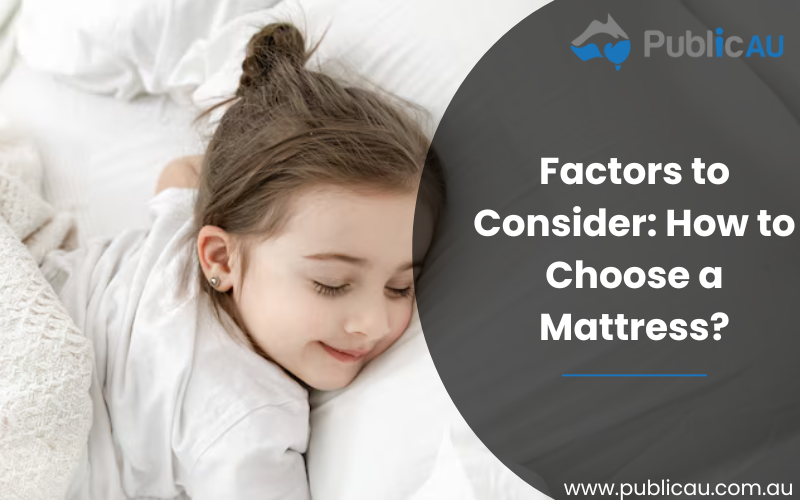
Are you tired of waking up feeling achy and unrested? It might be time to consider investing in a new mattress. With so many options on the market, selecting the perfect one can feel overwhelming. But fear not! In this blog post, we will break down the 5 key factors you need to consider when choosing your next mattress, ensuring you get a good night’s sleep every night. Let’s dive in and find the perfect match for your sleeping needs!
Choosing the right mattress is crucial for promoting quality sleep, preventing body aches and supporting overall health. Consider your personal preferences and physical needs when selecting your next mattress, and don’t hesitate to try out different options before making a decision. After all, finding the perfect mattress is an investment in your well-being and comfort every night.
Tips On How To Choose a Mattress?
Factor 1: Mattress Size and Space
The first step in determining the appropriate mattress size is to evaluate the amount of space available in your bedroom. It’s essential to measure both the length and width of your room accurately to ensure that you choose a mattress that fits comfortably without making the room feel cramped.
Once you have an idea of how much space you have to work with, it’s time to consider which mattress size will best suit your needs. The most common sizes are twin, full, queen, king, and California king.
Here’s a breakdown of what each size offers:
– Twin:
This is typically the smallest option and measures 38 inches wide by 75 inches long. It’s ideal for single sleepers or young children who don’t need much sleeping space.
– Full:
Measuring at 54 inches wide by 75 inches long, this size can accommodate solo sleepers who like a bit more room or couples who don’t mind snuggling up close.
– Queen:
With dimensions of 60 inches wide by 80 inches long, this is one of the most popular sizes for couples. It offers enough space for two people while still fitting comfortably into most bedrooms.
– King:
For those who prefer ample sleeping space or have partners who toss and turn during the night, a king-size mattress may be worth considering. It measures at 76 inches wide by 80 inches long.
– California King:
Similar to a standard king but longer in length (84 inches), this option is great for taller individuals or those who want extra legroom.
Factor 2: Type of Mattress Material
When it comes to selecting a new mattress, one of the key factors that should not be overlooked is the type of material used in its construction. The type of material used can greatly impact the overall comfort and support provided by the mattress, as well as its durability and longevity.
In this section, we will discuss the different types of mattress materials available on the market and their characteristics to help you make an informed decision.
1. Memory Foam –
Memory foam mattresses have become increasingly popular in recent years due to their ability to conform to your body’s shape and provide pressure relief. This material is made from polyurethane foam that has been infused with additional chemicals to increase its density and viscosity. It responds to heat and pressure, which allows it to contour around your body for a more personalized sleeping experience. However, some may find memory foam mattresses too hot or lacking in bounce.
Pros:
– Provides excellent support and pressure relief by contouring to your body shape.
– Good for people with back or joint pain as it conforms to their natural posture.
– Can absorb movement, making it a good choice for couples sharing a bed.
– Durable and long-lasting.
Cons:
– Can retain heat, making it uncomfortable for hot sleepers.
– Some memory foam mattresses may emit off-gassing smells initially.
– Can be more expensive than other materials.
2. Innerspring –
Innerspring mattresses are one of the most traditional types of mattresses available on the market. They consist of a network of metal coils or springs surrounded by layers of padding for added comfort. These mattresses offer good support and tend to have better airflow than other types, making them a good option for those who sleep hot at night. However, they may not provide enough motion isolation for couples, and they tend to wear out faster than other materials.
Pros:
– Offers similar benefits as memory foam but with better responsiveness and breathability.
– Naturally hypoallergenic and resistant to mold and dust mites.
– More durable compared to memory foam mattresses.
– Eco-friendly option as latex is derived from rubber trees.
Cons:
– May not provide enough support for heavier individuals due to its lower density compared to memory foam.
– Can be heavy and difficult to move around or rotate regularly.
– More expensive than other materials.
3. Latex –
Latex mattresses are known for their natural elasticity and responsiveness, providing both comfort and support without sagging over time. They are made from either natural latex derived from rubber trees or synthetic latex made from petrochemicals. Latex offers similar benefits as memory foam but with less heat retention and more bounce-back resilience.
Pros:
– Offers good support for all sleeping positions with various firmness levels available.
– Good air circulation keeps you cool at night.
– Affordable option compared to memory foam or latex mattresses.
Cons:
– Prone to sagging over time, especially if made with lower quality springs or coils.
– Noisier than other materials due to metal components rubbing against each other when moving on the bed.
– May transfer motion across the bed surface, causing disturbance for couples sharing a bed.
4.Wool-
Wool is a natural material commonly used in high-end luxury mattresses due to its hypoallergenic properties and temperature regulation capabilities. It acts as an insulator against both heat and cold while also being moisture-wicking, making it an excellent option for those who experience discomfort from temperature fluctuations during the night.
5. Hybrid –
As the name suggests, hybrid mattresses combine two or more materials to provide a balance of comfort and support. For example, a hybrid mattress may have a memory foam top layer for pressure relief and an innerspring core for added support. This type of mattress offers the benefits of both materials while minimizing their downsides.
Pros:
– Combines the benefits of memory foam or latex with the support and bounce of innerspring mattresses.
– Good for people who want a balance between comfort and support.
– Offers better motion isolation compared to traditional innerspring mattresses.
Cons:
– Can be more expensive than other mattress types.
– May not offer enough contouring for those with specific pressure points or body pains.
– Can have a shorter lifespan compared to memory foam or latex mattresses.
When considering the type of mattress material, it is important to weigh factors such as comfort, support, durability, and personal preferences. Remember that no single material is perfect for everyone; therefore, take your time and carefully consider which one will best suit your needs before making a decision.
Factor 3: Firmness Level
So how do you determine the right level of firmness for your next mattress? The first step is to consider your sleeping position. If you are a side sleeper, you will likely need a softer mattress as it allows your hips and shoulders to sink in comfortably. Back sleepers should opt for medium-firm mattresses that provide adequate support for their spine while keeping their body in proper alignment. For stomach sleepers, a firmer mattress can help prevent their hips from sinking too deeply into the bed and causing strain on their lower back.
When it comes to selecting the perfect mattress, one of the most important factors to consider is firmness level. This refers to the level of support and comfort provided by a mattress, and can greatly impact your overall sleep experience.
There are generally three categories of firmness levels: soft, medium, and firm.
Each person’s preference for firmness may vary based on their body type, sleeping position, and personal preferences. Therefore, it is crucial to understand how different levels of firmness can affect your sleep before making a decision.
1. Soft – A soft mattress typically has more give than other options, allowing your body to sink into it slightly. This can be beneficial for side sleepers who need extra cushioning for their shoulders and hips. However, if a mattress is too soft, it may lack proper support and cause discomfort or even back pain.
2. Medium – A medium-firm or medium-soft mattress provides a balance between comfort and support. It allows your body to contour into the bed without sinking too much, providing pressure relief while also keeping your spine aligned.
3. Firm – A firmer mattress offers less give than softer options, making it better suited for stomach sleepers or those who prefer sleeping on their back. It provides ample support for proper spinal alignment but may not be comfortable for everyone due to its lack of cushioning.
Summing Up
In conclusion, selecting the right mattress for your needs requires careful consideration of several key factors. From understanding your sleeping habits and preferences to considering the size, material, and support level of a mattress, each aspect plays an important role in ensuring a good night’s sleep.
By keeping these tips in mind and taking the time to research and test out different options, you can find a mattress that meets all your requirements and provides you with quality rest every night. After all, investing in a good mattress is an investment in your overall health and well-being. Sweet dreams!



